Interesting Stuff
- When you print on a color laser printer, it's likely that you are also printing a pattern of invisible yellow dots.
These marks allow printer companies and governments to track and identify you -- presumably as a way to combat money counterfeiting. When one person asked his printer manufacturer about turning off the tracking dots, Secret Service agents showed up at his - Wooster Collective: Every Image Has A Story - "zbs Hyena Man"
"the original picture comes from a project of the photographer (Pieter Hugo) the title of the project is (The Hyena men of Nigeria) - Medellín’s Nonconformist Mayor Turns Blight to Beauty - New York Times
Cityâs mayor and the son of one of its most famous architects presses forward with an unconventional political philosophy that has turned swaths of MedellÃn into dust-choked construction sites. - weblogart: Synthetic Biology 3
Proceeding of Synthetic Biology 3 is now online ! - BBC NEWS | Health | Tummy fat 'can grow new breasts'
Scientists say they can create a fat mixture with concentrated stem cells, which, when injected into the breast, apparently encourages tissue to grow.
Yo! Here's the third* project born from the Interactivos? workshop held at MediaLab Madrid last month.
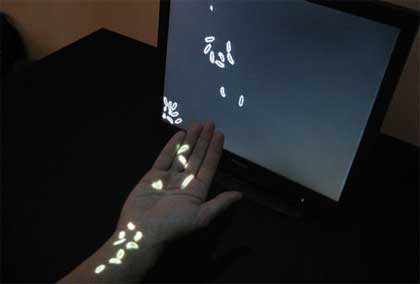
Delicate Boundaries, a work by Chris Sugrue, uses human touch to dissolve the barrier of the computer screen. Using the body as a means of exchange, the system explores the subtle boundaries that exist between foreign systems and what it might mean to cross them. Lifelike digital animations swarm out of their virtual confinement onto the skin of a hand or arm when it makes contact with a computer screen creating an imaginative world where our bodies are a landscape for digital life to explore.
Video.
What was the biggest challenge in developing the project?
The greatest challenge was that the piece dealt very directly with the human body. It was important to create the illusion that these animated forms (which my Spanish colleagues have fondly named
bichitos) have an understanding of the structure of the arm or hand they are exploring and can respond to it in a believable manner.
Interactive works are often facing the challenge of unpredictable audiences and responses, but attempting to respond so specifically to something as versatile and subtle as hand and arm movements was pretty challenging. I also wanted to create the experience that these lifelike forms that are made entirely of projected light had a physical presence in the world. It was certainly a challenge to design a system that convinced people to try to hold them and feel they had perhaps some responsibility for them.
Do you plan to develop the idea any further?
Yes, absolutely. I think there is a lot of potential for development.
The next release of the installation will integrate audio feedback. I began workgan working with several talented sounds designers during
Interactivos?, but did not have a chance to fully integrate it. I think an audio-visual synthesis will add to the sensory experience of the piece. On a more conceptual level, I plan to consider the idea that when two foreign systems or frontiers suddenly connect there is an inevitable change to both. So I am interested to find a subtle, but meaningful way to communicate that.
Looking further into the future, this project explores a lot of the concepts and questions I continue to research during my fellowship at Eyebeam. I am very interested in how digital artists deal with the human body. Although our bodies are so familiar and intimate I think they continue to be a source of mystery (at least to me) and it seems very human to try to use technology to explore and augment them. I also love work that wants to break free from the computer screen or other device, and I think a fascinating way to do this is to treat light as a living or physical force.
How does the system work technically?
The system design is not terribly complex. I use a digital projector mounted over the installation space for the projection onto the body.
A video camera and infrared illuminator are aligned with the projector to perform the vision tracking. The rest of the magic happens in the software which is written in C++ using the openFrameworks library. The program I developed (along with the help of several very talented collaborators) has three main components.
The first connects the various spaces of the installation (the video image from the camera, the projection space, and the computer screen). Understanding how these spaces connect physically was essential in creating a believable transference between the virtual and physical worlds. The next step was processing the live video to find different structural and motion information about the audience and how they are connected to both the screen and to each other. Finally, the fun part was designing the behaviors and interactions. I spent a fair amount of time finding the right marriage of form and physics to give the bugs some character and a sense of life. I have to credit Zachary Lieberman for all his help in programming the physics and motion in the piece.
Thanks Chris!
See also: Light bulb screen and Augmented Sculpture v 1.0.
- ZEMOS98 - Historias de control
historias de control que nos rodean una vez nos adentramos en el espacio público pero que, a un primer vistazo, son invisibles para la mayor parte de los ciudadanos: semáforos, videocámaras, radares, parquÃmetros o altavoces son algunos de los disposi - StrangeHarvest.com::Baltic Exchanged
London's Baltic Exchange - blown up by the IRA in 1992 by a fertilser bomb in a large white truck. Strange story whose resolution sees the old building heading for an unusual retirement. The Baltic Exchange is being rebuilt on the Baltic coast. - selectparks - Marketers pulling out of Second Life
primarily because the 'more than 8 million residents' figure on the game's Web site is grossly inflated. Also regular visitors are not only disinterested in in-world marketing, but actively hostile to it, - Photos of cephalopodic playscapes ::: Pink Tentacle
giant cement octopi posing as playground equipment in Japan. - Archinect : Disappearing Places
Anarchive and collective map of places that no longer exist, at least not as they once did. Users can upload stories and images about a place, link them to a corresponding location or street address and tag them accordingly, as well as browse the stories
My favourite movie ever is L'Atalante by Jean Vigo with the wonderful Michel Simon. Bibi has rescued Zero de Conduite (1933) and a couple of Documentaries by the French movie director.
Merci, merci Bibi!
One of the highlights of the We Love Technology day which took place on July 12 in Huddersfield was the keynote of architect Usman Haque. He titled it "I Hate Technology" and listed several things that bother him about technology. My rough notes:
The word "technology" means something different today than what it used to imply in the past. Technology used to imply "knowledge", it was the study of making. It was not an object but the description of an object. Technology was more about the description of systems. Today we tend to think that technology resides in physical things. That is a rather dramatic change, from the way we describe things to objects containing this thing we call technology.
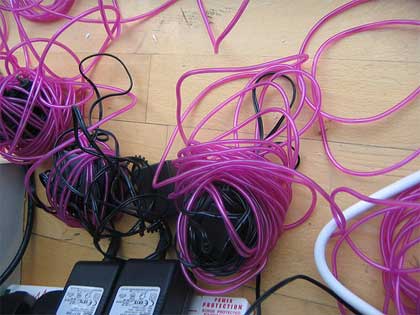
Consequence:
Artefacts. Fetishism for a piece of technology. You would never grab a frog and show it to people saying "this is wonderful biology!" or "Look at this biology!" We have developed a very mechanistic view of technology. Inspired by Steve Jobs?
A second problem is that we have the illusion of progress. When we think about technology, the words that spring to our minds are "innovation, value, efficiency."
But a look at train timetables (from 1973 to 1997) shows that even if loads of money has been poured into the train system, the trains actually got slower.
Example: Going from Portlaoise to Dublin took 51 minutes with steam engine in 1928, in 2006 it takes 55 minutes.
Philadelphia to Los Angeles in 1965 lasted 5 hours and 5 minutes. In 2005, the trip was 6 hours and 1 minutes.
- coin-operated » Mr.T1 - Determine Your Bandwidth Speed With Mr.T.
onstantly checks the current speed of the connected network and if it reaches that of a standard T1 line (1.5mbit/sec) or higher then a Mr.T sound sample is triggered in the form of âI Pity The Foolâ or one of Mr.Tâs other various sayings.
- Behind the Fiendish Complexities of Airfare Pricing
"If fares are atoms, priceable units are the molecules used to build complete tickets." - We Love to Fly and It Shows: Inside the World of Mileage Running
subculture of airline hackers called "mileage runners" who specialize in accumulating frequent flyer miles at low cost. - Eyebeam reBlog: personal powerPlant
a portable device that harnesses electricity through a solar cell and hand crank generator, into a NiMH battery. The device also includes a visual multimeter that monitors the amount of energy stored. The personal powerPlant can be used to power applicati
Another work developed last month at MediaLab Madrid during Interactivos?, a workshop focusing on magic and illusion (see also Augmented Sculpture v 1.0.)
Palimpsesto (video) is a sculpture screen made of "dead" light bulbs. Moving spots of light are projected on its surface and as a visitor comes closer to the screen, the light dots gather and re-create the silhouette of the person. The dead light bulbs seem to come to life again. The presence of a public metaphorically gives back their lost splendor to the bulbs.
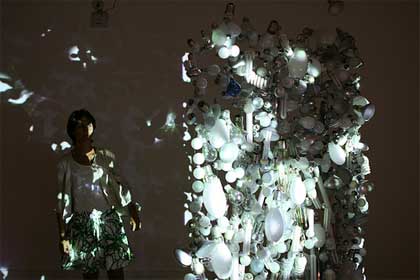
When i visited the workshop, i didn't get to see the installation working. Nevertheless, i found that the screen was really amazing (as was the amount of bulbs that had been broken in the process.) I recently asked Daniel Canogar, the creator of the project, to give us more details about it:
What was the biggest challenge in developing the project?
There were two basic challenges, and i can't quite pinpoint which was bigger. The first challenge was figuring a way of constructing a screen with dead light bulbs in an immaterial way,so that they would look like they were floating. During the installation, many light bulbs were broken, a whole string would come crashing down onto the floor, everyone would stop working and look at me, it was quite dramatic. Eventually I figured out how to do this and there were no further problems.
The second biggest challenge for me was coordinating with the programmer. It was hard to be patient while Jordi, my main programmer who was terrific, typed away for hours trying to get the effects that I was after. In the end he did a terrific job, and was worth the wait.
Do you plan to develop the idea any further?
I consider the piece at the Media Lab a prototype, which is going to be made much larger in the following months. The piece will be featured in a large new media show that is opening in the Reina Sofia Museum in Madrid June 2008, a show called "Maquinas y Almas" (Machines and Soul) curated by Montxo Algora. I plan to develop the piece more with MediaLAb, who have being absolutely amazing to work with. They have a real interest in research projects, and want to take my piece on to develop it more.
How does the system work technically?
When first encountering the sculptural screen made of dead light bulbs, the viewer sees these free-floating white particles flying about. The video projector casts these spots of light on the light bulbs, which makes them look like they magically give light again. When the viewer gets close to the screen, a web-cam hidden amongst the light-bulbs captures his/her silhouette and this information is processed by the Open Frames software and makes the free-floating light particles cluster together. The resulting light-blob loosely has the sas the shape of the viewer's silhouette, and follows him/her as they move along. It is the viewer that brings new light to these dead light bulbs, brings forth the memory of these discarded artifacts.
Thanks Daniel!
Image Medialab interactivos.
 Bit slow with the blogging cuz i do not always have access to internet but service should resume as normal from tomorrow on.
Bit slow with the blogging cuz i do not always have access to internet but service should resume as normal from tomorrow on.
Late notice but i hope some of you can come and enjoy a Biorama afternoon in Huddersfield. The event is bringing together artists who explore notions of life, science and digital realities.
This morning Andy Gracie (hostprods), currently in residency at DRU, and Brandon Ballangee will take us for a hike around Marsden Moor, traditional and digital networking systems, satellite communications, perceptions of landscape and the history and possible future of interstellar communication. The walking talk will cover the parallel conceptual territories including the topography of local transmission masts, the history of interstellar communications, the landscape painting tradition and the micro ecology of the moors. Simple scientific field experiments and samplings will be carried out at various points on the way which will provide a window on the methodologies and concepts which Andy has been attempting to weave together throughout the residency.
The Biorama Sessions are free and open to the public. They will start at 3.30 p.m. at the Media Centre.
In each session, two artists will present their work and explore common territories before brief open discussion.
Participants: Agnes Meyer-Brandis, Andy Gracie, Brandon Ballengee, C-Lab, etoy, France Cadet and London Fieldworks.
Image: Brandon Ballengée, Green frog (Detail).
- Behind the Fiendish Complexities of Airfare Pricing
"If fares are atoms, priceable units are the molecules used to build complete tickets." - We Love to Fly and It Shows: Inside the World of Mileage Running
subculture of airline hackers called "mileage runners" who specialize in accumulating frequent flyer miles at low cost.
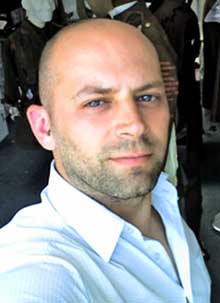 Back in 2004, i stumbled upon a project called The Face Corset. Designed by Paddy Hartley to simulate the effects of cosmetic surgery, they were one of his first comments on and explorations of cosmetic surgery and our culture's obsession with beauty. Furthermore, the artist collaborated with Biomaterials Scientist Dr Ian Thompson to adapt the corsets into facial dressings that could protect and support the face during the recovery period after surgery or skin grafting.
Back in 2004, i stumbled upon a project called The Face Corset. Designed by Paddy Hartley to simulate the effects of cosmetic surgery, they were one of his first comments on and explorations of cosmetic surgery and our culture's obsession with beauty. Furthermore, the artist collaborated with Biomaterials Scientist Dr Ian Thompson to adapt the corsets into facial dressings that could protect and support the face during the recovery period after surgery or skin grafting.
With Project Facade, the second step into this research, the artist is looking into the personal and surgical stories of soldiers who, disfigured in battle during the First World War, had to undergo pioneering surgical reconstruction. "The very nature of trench warfare, moreover, proved diabolically conducive to facial injuries: "[T]he...soldiers failed to understand the menace of the machine gun," recalled Dr. Fred Albee, an American surgeon working in France. "They seemed to think they could pop their heads up over a trench and move quickly enough to dodge the hail of bullets." (via)
Working from original patient and surgical notes along with personal family archive material of the men, Hartley designs, modifies and embroids uniforms similar to those the servicemen fought in. Each garment tells the fragmented personal history of a man who had to go back to his families with a seamed and shattered face.
Working in partnership with Gillies Archive Curator Dr Andrew Bamji at Queen Mary's Hospital Sidcup and Dr Ian Thompson at in the Oral Maxillofacial Dept, Guys Hospital London, the project allows Hartley to examine and respond artistically to the origins of surgical facial reconstruction, compare current techniques in facial surgery and the development and implementation of bioactive materials for the repair of facial bone injuries.

Victor T.
What prompted your interest in the origins of surgical facial reconstruction techniques?
Even though I trained in ceramics and sculpture, I've always been more interested in human biology, technology, and engineering, that sort of thing than in art. I see the Artistic/creative process as a vehicle for the examination and combination of âanything with everythingâ. So much of the work I produced at University and in my early career was about anything other than âArt or the Artistâ. Examining the use/abuse of Steroid in bodybuilding, religious organizations shifting attitudes towards medical technologies and recently the origins of facial reconstruction.
Having seen some of my previous work using medical equipment, I was invited by the Victoria & Albert Museum in London in 2002 to exhibit work for an evening-long event called âShort Cuts to Beautyâ which consisted of a series of public demonstrations, presentations and debates on âbeauty industriesâ and their impact on society today. Not having anything appropriate for the event in my back catalogue, I proposed I make new work for the event and considering one of the topics up for discussion was extreme cosmetic surgery and the use of facial implants, it seemed appropriate to make work based around a hypothetical of facial surgery as taboo. What if it was considered taboo in todayâs society to alter the structure of the face surgically for cosmetics alone? How could an individual radically alter the structure of the face without the use of surgery? Corsetry immediately sprang to mind (particularly as I left the V&A after my meeting I left via the Dress Gallery and saw the collection of corsets on display). If it was possible to alter and âtrainâ the structure of the body with a garment, could I do the same with a âfacial corsetâ to shift the soft tissue of the face?
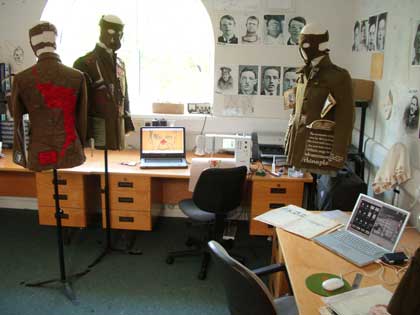
Paddy Hartley's studio
So having never even sat at a sewing machine, I set about making patterns based on my own face (the only one readily available!) and getting to know the basics of garment construction. The original idea was to make âneutralâ looking garments from white fabric incorporating external âadornmentsâ using commercially available facial implants. This was how I came to meet Biomaterials Scientist Dr Ian Thompson at Imperial College London via recommendations from the Science Museum, London. I originally approached Ian to try and obtain some commercially available facial implants but when I saw the work he was doing making Bioactive glass facial implants for the repair of bone facial injuries, I thought I just had to incorporate these into the âFace Corsetsâ, which as it turns out, we did. As far as the Corsets themselves were concerned, an unexpected (yet with hindsight totally foreseeable outcome) was that the tighter the garment was fixed to the head, the more the wearer was able to reposition the exposed skin.
The presentation of the work at the V&A event really was the start of a long working relationship between Dr Thompson and myself. My skills in developing the casting of the implants with Ian coupled with his vision of the âFace Corsetsâ as potential pressure dressings cemented our working relationship and the logical next step was to seek funding to pursue our collaboration. Obtaining our first grant from The Wellcome Trust allowed us to develop the work full-time for a year but if the truth be known, quite early in the project my interest turned to the origins of facial reconstruction.
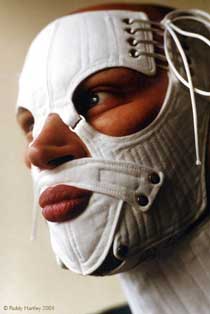
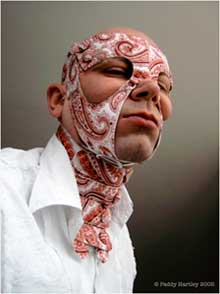
First Face Corset and Paisley
How has the public reacted to the Face Corset when you exhibited the work?
Very mixed, sometimes with a raised eyebrow, sometimes with a knowing look, sometimes with a chuckle. Everyone brings their own interpretation which, to a certain degree is great because I didnât intend to load the work with meaning. They are physical devices built around a âfunctionalâ brief. What I have found though is that the majority of people see a facial garment as a device to hide the face, often referring to the Face Corsets as Face âMasksâ. As I see it a mask is intended to hide the identity of the wearer whereas the Face Corsets are intended to alter the appearance of the wearer by manipulating the skin of the wearer. The intenhe intention is do âdisplay the wearer in a different wayâ.
Many people seem to assume that a facial garment has some kind of sexual connotation. I tell you, the amount of enquiries I've had from PVC clad âexoticsâ looking for a bespoke PVC Face Corset. Thatâs not my scene and not why I made the work, which is why I've never sold or given a piece away. I donât want to be responsible for making something that could cause physical harm to a wearer/user. There did come a point where I decided to make the Face Corsets out of fabric as far removed from the S&M scene as I could imagine. I used old suit material, my old shirts, that kind of thing but regardless, the facial locating of the Face Corsets was still read by viewers and having aesthetics which alluded to a sexual/menacing/disguising. This is why I âburiedâ the Face Corsets.
What exactly are the Bioactive© glass facial implants you mentioned earlier?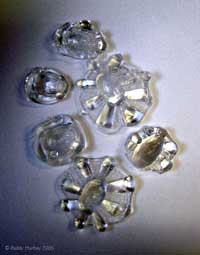
The implants are made from a special glass that contains a combination of other components that make the glass less prone to rejection by the body. Bioactive glass was invented by Prof Larry Hench as a material to repair massive bone injuries of US servicemen injured in the Vietnam War. Even though the Bioglass© in a powdered/paste form did bond bone fragments, the material was not load bearing. Dr Thompson (Ian) has recently been casting the glass into small monolithic forms to repair non-load bearing bone injuries, particularly of the face. When I came on the scene, Ian was by his own admission using fairly primitive casting and carving methods. The skills I acquired in mold making and casting I picked up at University and at a later post in bronze casting foundry enabled me to work with Ian to try out new lost-wax casting techniques for the production of patient specific implants. Since then, the production methods of the implants have advanced and this element of the collaboration has run its natural course.
For âProject Façadeâ you collaborated with Dr Andrew Bamji, Consultant Rheumatologist and Curator of The Gillies Archives, and Dr Ian Thompson from the Department of Oral Maxillofacial surgery at King's College. How did you get to work with scientists?
Itâs always the ideas for the work I make that lead me to meet the people I work with whether they be Dress Historians at the V&A, Scientists at University Hospitals, Family Historians based at the National Archives at Kew or Army Surplus suppliers in Portsmouth. I donât have a specific desire to work with scientists, thatâs just the direction the work has taken me.
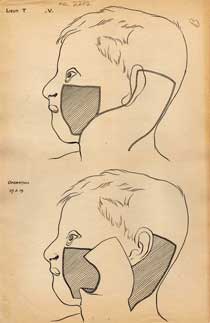

Top V: Sketch proposing grafting skin to replace scarred cheek and Skin from tubed pedicle 1. in place on chin and nose.
How difficult has it been to trace the records of men injured and disfigured during the First World War? Can you tell us the story of one of those injured Servicemen that you found particularly touching/interesting/meaningful?
In so far as tracing the medical records, this was pretty straightforward. When I first became interested in finding out more about the origins of facial reconstruction, I recalled seeing a very short clip of an interview on a TV documentary which mentioned the pioneering surgery developed by Sir Harold Gillies during the First World War to repair horrific facial injuries. A web search brought the Gillies Archive to my attention so I booked an appointment to meet the Curator Dr Andrew Bamji (who was the chap on the TV documentary) and see some of the records. On first sight I was overwhelmed by the amount of material Andrew had collated. The Archive holds somewhere in the region of 2500 documents recording with photographs, pre-op sketches, plaster casts and handwritten notes, the surgeries the patients underwent under Gillies.
I was originally drawn to the Archive because of an interest in the surgery yet I found myself becoming incredibly curious to find out more about the post-surgery stories of the men treated by Gillies. However, only a handful of the records Andrew has collated tell the pre-injury and post-surgical stories of the men and this is largely due to Gillies patients sending him photographs and letters to let him know how they were getting along in life.
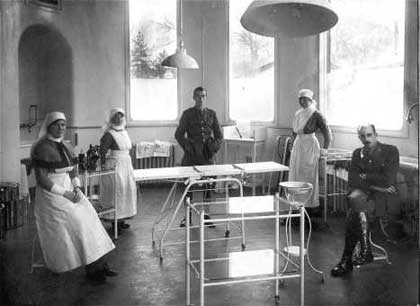
The Plastic Theatre, Queen Mary's Hospital, 1917. Harold Gillies is seated on the right (image reproduced from the Gillies Archive)
I was keen that the work I was embarking on making didnât just tell the surgical stories of individual men but the personal stories also. I didnât want the men to be defined by their injury and subsequent surgery. So once I had selected a small group of men whose stories I would like to tell, I employed Genealogist Elizabeth Evans to take the information we had and on the 10 men I had selected and search the archives at the National Records Office at Kew to see what additional information we could find. Some of the men had very little information other than census records and Regimental war diary entries by their Commanding Officers. Others however had details on the menâs trade before joining the Armed Forces, details of family members and in one case in particular, personal letters from nursing staff pleading with higher ranking officials for patients to be admitted to the plastic surgery unit at Sidcup for their facial injuries to be treated.
There are so many stories that have emerged over the past two years its hard to say which has touched me the most. Willie Vicarage the Welsh watchmaker who was so badly burned in the Battle of Jutland he lost most of the skin from his face, his nose, parts of his ears and almost all of his fingers. Alfred Russell who received skin grafts from his buttocks to his cheeks. Alfredâs wife Florence would joke that when kissing him on the cheek she was actually kissing him somewhere else! Itâs the story of 2nd Lieut Henry Ralph Lumley that really got to me.
Henry, son of Robert and Florence and elder brother of Molly was a well-educated young man working for the Eastern Telegraph Company. Having not being a member of the Officer Training Corps Henry went out of his way to train as a pilot sought special permission to do so for which he was granted and attended Central Flying School, Upavon from 15th April 1916. The 16. The first tragedy to strike was on the very day Henry graduated from flying school when his plane crashed and he suffered horrific facial burns. A letter from Central Flying School to his mother stated on the same page that her son had graduated and that his aircraft âmet with an accidentâ.
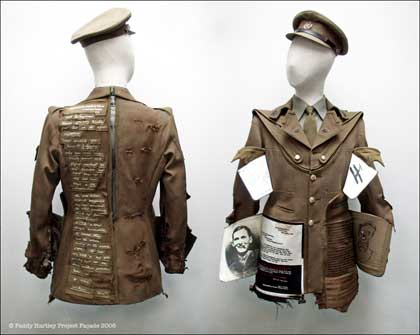
Lumley
Roughly a year after his crash, Henry was transferred to Sidcup for reconstructive surgery under Gillies who proposed removing Henryâs badly scarred face entirely and replacing it with a single, huge skin graft taken from Henryâs chest. A similar less extensive procedure had proved highly successful for the aforementioned Willie Vicarage a month earlier. Henryâs surgery was more ambitious and partially due to Henryâs weakened condition the graft rejected and Henry died a few days after his surgery.
Gillies continued to encounter similar injuries to pilots and sailors and as a result of the failure of Henryâs surgery; Gillies began repairing full facial burns in stages, thus giving the patient chance to recover between surgeries. Henryâs death brought about an entire reassessment as to how to treat such injuries and hundreds of patients benefited from what was learned from Henryâs tragic surgery and paved the way for the highly successful skin grafting surgery performed on the self styled World War 2 pilots âThe Guinea Pig Clubâ over 25 years later.
As a result of the record search, I discovered Henry was buried close to my home so I took it upon myself to visit his grave. Something I never envisaged doing at the beginning of the project. Tucked away in Hampstead Cemetery is a small family headstone naming his mother, father and sister along with Henry. Sitting by Henryâs headstone for a couple of hours and being physically that close to him made me realize this was more than just âa projectâ to me. Here were stories about incredible people that needed to be told.
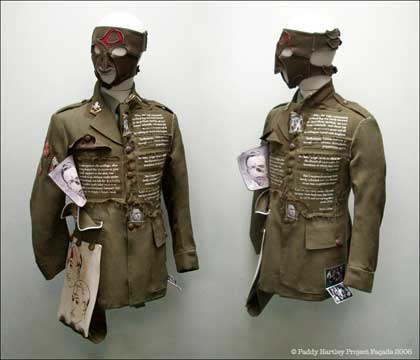
William Spreckley
For Project Facade you are creating a series of garments. What are you trying to achieve or communicate with these pieces? How do they complete or respond to your previous work, The Face Corsets?
The main aim of the work initially was to communicate an understanding of the pioneering surgery Gillies performed on his servicemen patients. Now though it is more about telling the stories of the people who underwent this surgery, who they were, how they came to be injured, illustrate the surgery they underwent and how they dealt with the physical and psychological consequences of receiving this surgery. Iâm very much a believer that âyou wear your history on your faceâ, particularly with these men. The military uniform, itself a record of the wearers military service, seemed a perfect vehicle to tell these fragmented âpatchworkâ stories. Gillies patients ended up âwearingâ their military history on their faces for the rest of their lives. The uniform sculptures and accompanying face garments pool all the information I have from a variety of sources to present a collage of experience of that individual. The facial garments made from identical fabric as that of the uniforms represent the military history being worn on the face and act as an anchor point for the illustration of movement of skin by Gillies from other parts of the body to the face. I was keen that the work did not replicate injury. That in my opinion would be crass.
As far as Iâm concerned, if the work I make merely provokes viewers to want to find out more about these amazing heroic people and acknowledge their sacrifice, it has been successful.

Walter F.
Did the fact that you have spent several years working on this project changed the view you have on your own appearance, the fact that cosmetic surgery is getting mainstream and (if you have any) beauty ideals?
Actually yes. In my youth I was something of a âpeacockâ. Because of the last couple of years work, I donât worry about putting on a little weight, the dark circles under my eyes, my slightly less elastic skin. This is just how I am. Iâm more concerned that my back doesnât work quite as well as it used to. I must say though, the plethora of cosmetic surgery TV shows really makes my blood boil I just wish a fraction of airtime was given over to tell the stories of the servicemen Gillies treated to restore function to their faces as is given over to people having the fat sucked out of their backsides.
Speaking personally, my beauty ideals tend to be personality based but if we are going to get superficial, I do like ladies with gaps between their front teeth that speak with a lisp and a top lip that looks like its been smeared flat! I find difference attractive.
What can members of the scientific community learn from your own artistic research?
Speaking very generally, to be open to collaborate across disciplines, but that goes for anyone in any profession, but not to âforceâ the collaboration. Let it take you where it will. Fellow artists have asked me on a number of occasions as to how they can have their work taken on board as part of clinical practice in health care and my answer never changes. âI donât know!â That has never been an aim of the work I set out to do. If it contributes towards clinical practice by proxy, thatâs great because its evolved naturally rather than by design. As far as Iâm concerned the main audience I want to connect with is the general public. Essentially thatâs who the work is about.
Any upcoming projectâs that you could share with us?
Project Façade Phase 2. Iâm trying to trace as many descendants of Gillies patients to record their memories of their âGillies repairedâ relatives to find out and preserve their later life experience. This has becoming a life long undertaking for me.
Thanks Paddy!
All work produced by Paddy Hartley and associated Gillies Archive documents and objects can be seen at the first Project Façade exhibition âFaces of Warâ produced with and opening in Autumn 2007 at The National Army Museum, London.
For further details contact Paddy directly on paddyhartley at projectfaçade dot com or visit the project website to find out more about the stories of the men and Paddyâs responses.
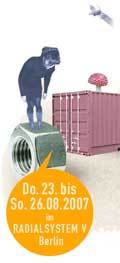 Off to Zürich for the Digital Art Weeks symposium and a very yummy-looking exhibition. After that i'll be in Huddersfield for We Love Technology, this year the event will focus on interactive architecture, sound and games.
Off to Zürich for the Digital Art Weeks symposium and a very yummy-looking exhibition. After that i'll be in Huddersfield for We Love Technology, this year the event will focus on interactive architecture, sound and games.
Then back in Germany. First in Kassel for, Paper and Pixel Week, a series of workshops and debates on the relationship between online and offline press, as part of Documenta's Magazine Project. The event is curated by our friend and guru Alessandro Ludovico. Then hop on the train and off to Dortmund for the Satellite Voyeurism workshop at the HMKW. Looking forward to that one too.
Say hi if you're around.
After that i'll spend some time in the most boring country ever because i need to get some rest from the constant excitement that Berlin provides me with. I'll watch tv series, try some new blueberry face masks and read detective stories. That's called holidays and i won't be back in Berlin before the 9to5 festival-camp in August. I didn't exactly get what it is about (alternative forms of works maybe?) except that it takes place from 9 in the evening to 5 in the morning, that everyone will be talking german but me, and that it is organized by the lovely Holm Friebe and when that guy asks you to "relocate your whole business" on the banks of the river Spree, you just follow the advice.
Lise Lefebvre recently graduated from the Design Academy Eindhoven with a lovely project which deals with sound in domestic appliances.
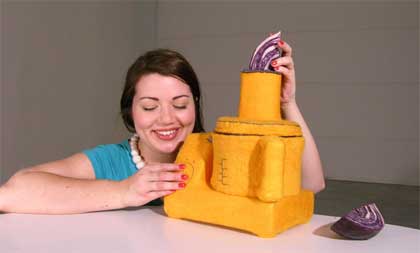
Weâre surrounded by objects that create noise as a by-product of their function, affecting our health and quality of life.
What if sound became a criterion for design? What would be the effects it could have on the look, feel, texture and overall experience of an object?
Lise´s handfelted domestic appliances are audibly, but also visually silenced. The fabric absorbs most of the sound coming from the motors. As Lise wrote me "the little objects in particular seem to be purring very gently."
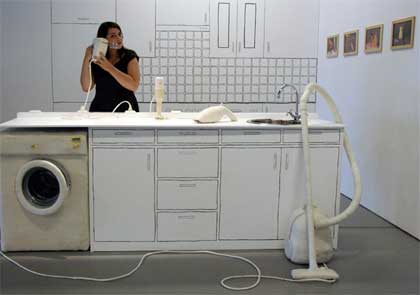
Pictures by Sander Lucas and Hans Tan.
More domestic appliances: Dancing appliances, music from the kitchen, The Turnatable Microwave, Your head inside the washing machine, Manolo is gonna have fun, In the Kitchen, VJ Sewing machine, Machine therapy, etc.
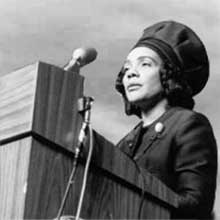 The Port Huron Project is a series of reenactments of protest speeches from the New Left movements of the 1960s and '70s. Each event takes place at the site of the original speech, and is delivered by a performer to an audience of invited guests and passers-by. To reach a wider audience, videos of these events are distributed on DVD and posted online. The project is named after the Port Huron Statement, the manifesto of the Students for a Democratic Society (SDS), a student activist movement formed in 1962.
The Port Huron Project is a series of reenactments of protest speeches from the New Left movements of the 1960s and '70s. Each event takes place at the site of the original speech, and is delivered by a performer to an audience of invited guests and passers-by. To reach a wider audience, videos of these events are distributed on DVD and posted online. The project is named after the Port Huron Statement, the manifesto of the Students for a Democratic Society (SDS), a student activist movement formed in 1962.
The first event in the PHP series, Port Huron Project 1: Until the Last Gun Is Silent, took place on September 16, 2006 and was based on a speech given by Coretta Scott King at a peace march in Central Park in 1968.
The next re-enactment will take place on Saturday, July 14, 2007, at 5 p.m. in the Boston Common park, an actor will deliver a speech given by Howard Zinn at a peace rally in May 1971. Zinn was arguing for the necessity of civil disobedience to protest the war in Vietnam and called on Congress to impeach the president and vice president of the US for the âhigh crimeâ of waging war on the people of Southeast Asia. The performance, titled Port Huron Project 2: The Problem is Civil Obedience.
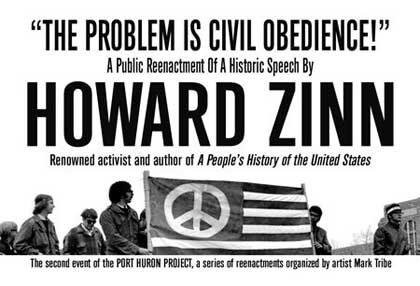
The Port Huron Project is organized and curated by Mark Tribe, i asked him a couple of questions about the projects:
Why do you think it is important to reenact protest speeches from the '60s and '70s? Is our decade not protesting enough? Have we lost something?
I think we have a different, and perhaps diminished, sense of what's possible today compared to the '60s. In his speech at the March on Washington in 1965, Paul Potter talked about changing the system. We protest the war in Iraq, or the WTO, but it's hard to imagine that we could really change things in a radical way: put an end to the military industrial complex, replace consumer capitalism with another form of economy, or achieve true democracy. Back then, people seemed to be able to imagine a radically different future. I think it's vitally important that we recapture some of that utopian spirit.
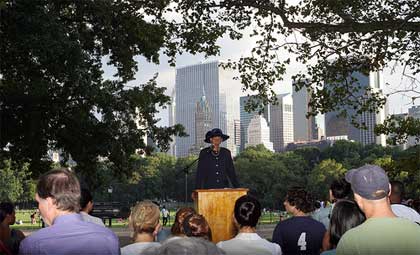
How do you choose the speeches you are going to reenact? Do they have to echo a particular current event or is the choice driven by other reasons?
Most of the speeches talk about Vietnam and link it to domestic issues such as poverty and racism. I do see uncanny parallels between Vietnam and Iraq, and although more progress may have been made on social justice and liberation, those issues are very much alive today. So in choosing speeches to reenact, relevance is definitely a big factor. Other considerations are the quality of the speech and the location--for the purposes of this project, they have to have been delivered at a public protest.
Thanks Mark!
A list of historic protest speeches has been compiled.
Related: The exhibition History Will Repeat Itself currently running at the Hartware MedienKunstVerein in Dortmund focuses on current strategies of re-enactment in contemporary (media) art and performance.
Image 2 via newsgrist.
- Boing Boing: Possible "octosquid" discovered
This creature, apparently a half-squid, half-octopus, was found off Hawaii's Big Island. Possibly a newly-discovered species, it was accidentally sucked up into a deep-sea water pipeline from a depth of 3,000 feet. - X-Sounds
july in kreuzberg - sound art - Eyebeam reBlog: Announcement: New Wooster on Paper Book - "All My Friends Are Made Of Paper"
latest limited edition book in our "Wooster On Paper" series
This is the way i was playing pacman aaages ago and i never went beyond that cardboard point. Yosuke Ueno's version of Mario is just my kind of video game too.
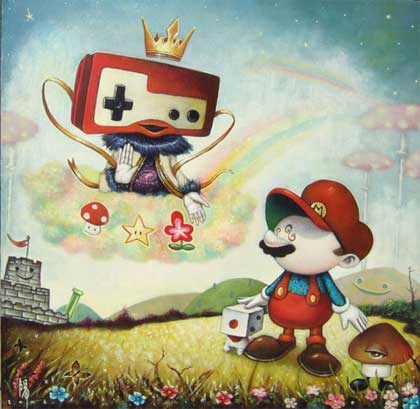
beginning The Great Adventure
Via las insolitas aventuras del pez.
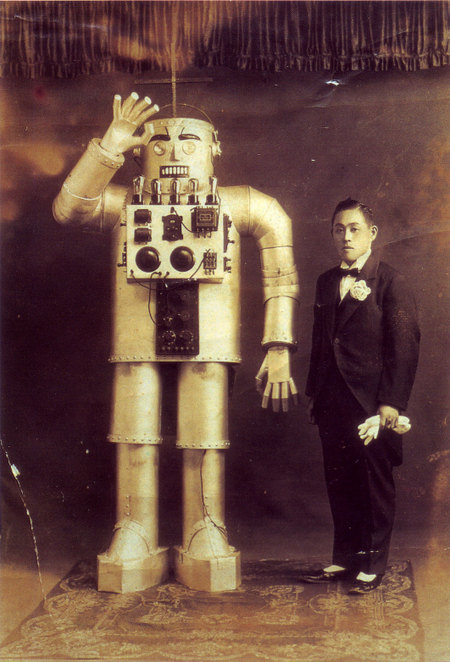
Yasutaro Mitsui with his own steel humanoid, early '30s.
Via Hugo Strikes Back (information about the picture found in Book review: Loving The Machine: The Art and Science of Japanese Robots.)
- Free Soil - Warning art
Here are the ten art projects that deal with the subject of Climate Change, - metroZones
texts from the five metroZones books listed below. The books are the results of the project "ErsatzStadt" (Substitute City). - Silicon Valley subculture of stuffed animals is the largest in the world
The Internet Furry Proximity Locator, a geographic site that plots furries by zip code, identifies Northern California as a national hotspot.
Today our home rely on a network of cables, pipelines and connections. Most of the information we have access to is passing through these "roots." ASCII-Code curtains, by Dutch designer Nienke Sybrandy, visualize the information network in a tree, using the very codes that represent text in computers, communications equipment, and other devices that work with text.
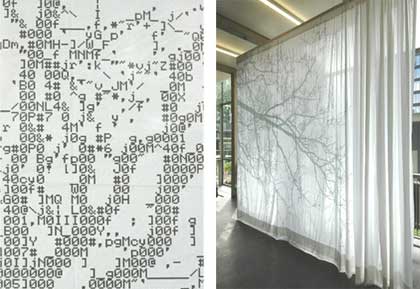
Via Beton & Garten. I tend not to read blogs written in a language i cannot understand but there are exceptions, Beton and Garten is one of them.
Meet one of my favourite Berliners! Christine Hill invited me last year to give a talk at the Bauhaus University in Weimar where she heads the Department Media, Trend and Public Appearance. That's how i got to know her, i then googled her name and immediately realized the extent of my ignorance when i discovered that she has been exhibiting all over the world with a very unconventional and intriguing project (or should i label it "production label"?) called Volksboutique.
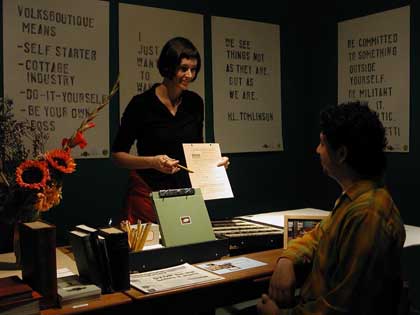
Volksboutique began as a thrift store/sculptural installation in Berlin back in the '90s when she left New York and landed in Germany. Visitors would open the door to her underground shop, tea was served, clothes were cheap and people congregated to discuss topics ranging from identity and self presentation, to weather and the effect of tourism on the neighborhood (via).
Volksboutique projects kept on evolving, surprising and questioning the audience and the art world. She franchised the boutique for Documenta X in Kassel in 1997, then abandoned her role as a salesgirl and mutated into a late-night talk-show host, a tour guide, a masseuse, a handbags and retro-looking stamp kits designer, etc. Turning everyday job into an artistic activity that could either be presented inside galleries or taken on the road inside carefully crafted trunks.
She is currently showing one of Volksboutique manifestations, Minutes, at the Venice Biennale of Art. This interview was made before the Venice art exhibition.
A book about your work "Inventory : The Work of Christine Hill and Volksboutique" has been published recently. How did it feel? Like a chapter of your professional life that had been turned?
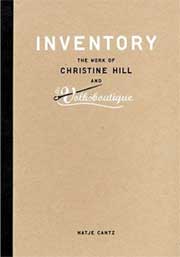 Not to invoke a too-female metaphor here, but that book was as much birthed as it was published. The compilation process was pretty strenuous and I almost fell over when my editor mentioned that "the next book will be much easier" for inability to ever comprehend ANOTHER book. But indeed, there will be another book, as soon as this month! So, I survived the first Volksboutique Inventory. But of course, haurse, having an opportunity like that one was incredible, and making the book into a project became my primary task that entire year. I like to keep order, and surveying the projects made since I really began working professionally (depending upon when that actually was) was incredibly satisfying.
Not to invoke a too-female metaphor here, but that book was as much birthed as it was published. The compilation process was pretty strenuous and I almost fell over when my editor mentioned that "the next book will be much easier" for inability to ever comprehend ANOTHER book. But indeed, there will be another book, as soon as this month! So, I survived the first Volksboutique Inventory. But of course, haurse, having an opportunity like that one was incredible, and making the book into a project became my primary task that entire year. I like to keep order, and surveying the projects made since I really began working professionally (depending upon when that actually was) was incredibly satisfying.
Initially, I thought of this book as a sort of end of year Annual Report, and was thinking of course about summing up.
I also was glad to have the opportunity to formally define what makes up Volksboutique for me, as it has often been (mis)understood as solely a second-hand shop. The book was the opportunity to show breadth, and to also underscore the aesthetic and "philosophical" stance I take. I also write a fair amount, and the book was the perfect showcase for that activity.
It was an incredibly tidy feeling to draw the line somewhere and say to myself "All this has been accomplished", but then a sort of enormous void was staring at me, as in "what now?" This is rather familiar to me after large projects.
And as I've gotten increasingly interested in libraries and other archiving systems, I am happy to be working on books that can show that interest.
Why these deliberate confusions between art and commerce?
Well, I'm quite interested in properly defining which things are assigned value. And I'm very preoccupied with what counts as labor.
This began quite practically following my move to Berlin in 1991 â" with my larger project of assimilating. It is noteworthy that I had no real permission to work here, and so I devised series of service pieces in the early 90s, where I, for example, worked as a masseuse, largely for tips. Also, that I was included in (and working for) numerous group shows all over Europe at this time, and realized that, rewarding as that is, it doesn't pay money.
This idea of merging income and art occupations culminated with opening the Volksboutique-as-shop in 1996. It was a way of claiming autonomy. It both freed me from being anyone's employee, and launched me straight into Proprietor-status, and it absolved me from having to rely on the art system to provide me with an audience. It allowed me to build a base of operations, and work from it, which is a device I've held onto over years.
My work path over years has continued to punctuate my thoughts on this, in the form of anecdote or in specific exhibition or project experience. A museum I did a project with revoked a small production fee when they discovered that the piece I had made â" a vending machine â" was turning a small profit within the exhibition itself. Hundreds of visitors to my installation at documenta X (a franchise of the Volksboutique shop, installed in the exhibition) complained loudly that this "wasn't a commercial exhibition!", missing the irony that, for example, a Jeff Wall was hanging directly opposite my store. Numerous visitors (including a reporter from The Wall Street Journal) found my $12 tour fee as part of my Tourguide? piece in New York city excessive, although that is exactly the sum charged by all tour guide agencies in the city. A museum director in Italy refused to refund my travel and production costs for the installation, barking at me that I was "lucky to be in Italy".
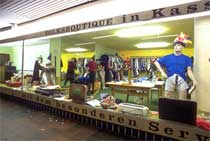
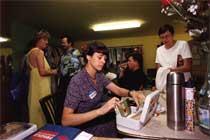
Volksboutique Franchise, 1997
On the one hand, we have art fairs and Sotheby's auctions reminding us all the time about the financial inequalities or excesses of the art system, but then, on the other, we have puritan calls for the work to be freed of economics so that it can exist in some reality-free bubble. And I disagree with both of these extremes.
Of course, I am isolating these experiences to underscore this particular point. It should not be misinterpreted that my entire work path has been a litany of complaint or abuse. To the contrary. Most artists I know find themselves being pushed forward by "mistakes" or such experiences, and I am no different. Hitting a point of adversity, whether within one's own process or from the outside, pushes things forward.
Basically, I identify with being a working artist - I work hard in order to live from this and live AS this. And it's important to me to feature that in projects. And it is important that that include financial aspects.
Of course, when I am involved is larger scale projects â" which I call "Organizational Ventures" â" that contain large amounts of administration, preparation, and on-site labor, I am often asking myself what I am trying to prove to myself by creating these insanely confounding schemes. It IS the addition of chaos, of overwhelming-ness, of over-stressing productivity that ends up defining many of these projects.
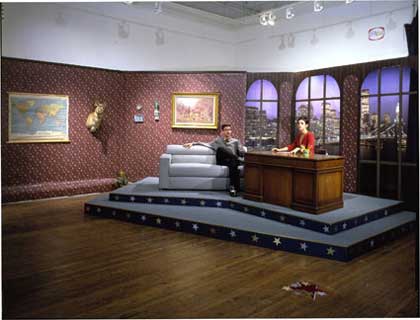
Pilot, 2000
Do you perform or role-play with Volksboutique? How do you differentiate one from the other?
It is good that the the word "performative" has entered the general art vocabulary, because it rescues work like mine from being labeled as Performance Art. I am extremely averse to theater, because I don't want to see a simulation of life. I want life. I want things real and in real time. And there is always going to be that unfortunate leap the mind makes when hearing the phrase "performance art" that conjures the stage whisper, or someone setting themself on fire. So I don't consider myself to be performing in the sense that we understand "acting" or staging. But I DO find that the entire thing is about performance, in terms of what in German is the word Leistung. And I do have a certain public persona that is in the work (and probably in my teaching as well). It is a part of my own personality, not something that is assumed, but it is also specific to certain projects that contain an extroverted element. Initially, my labors in the Volksboutique were specifically about pointing directly to the fact that this was an occupation. Something all-consuming, that required a sweat to be broken. And about clarifying that my own person/a was the guide through this set of ideas. This is also a way of addressing accountability and responsibility. Projects of mine require participation of various levels by viewers. How much they can access has in part to do with how they approach me as the representative of any given work. I feel this is a fair exchange, similar to any in a shop transaction.
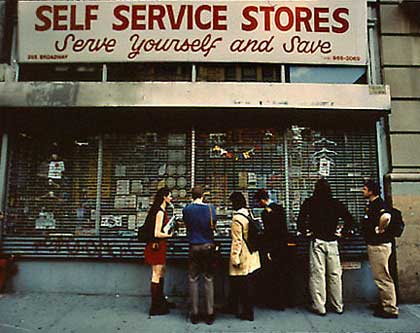
Tourguide?, 1999
Which criteria guide the choice of the identities you adopt in the Volksboutique performances?
I spent one year at a university before switching to an art school, anhool, and while I was there, I remember being astonished at the number of extremely focussed majors some people had. I had no idea that these occupations existed. In high school, I was told by those in the position of advising me that I would be a good artist or a good lawyer. (I will assume because I was generally considered a "creative type" but I was also extremely loud and opinionated.) My step-mother thought I should become a dental hygienist. Upon graduating from art school, though my occupation as artist was never really something I questioned, I realized I missed many aspects from other occupations. I remain infinitely curious, for example, about office culture, although I've never worked in a true cubicle-zone ever. My initial incarnation as shopkeeper at the Volksboutique was mostly informed by my taking German service culture to task, not to mention wanting to define publicly what I felt was the role of the artist in the society, and that this was a service providing role. Thereafter, I began investigating which jobs would best illustrate my preoccupations. I am particularly interested in librarians now, for example.
I suppose it is redundant to mention these works also point out my femaleness to an extent. Either I have chosen to take on some stereotyped female roles (shopgirl, librarian) or I am intentionally trying out things that fewer women end up in (late night talk show host).
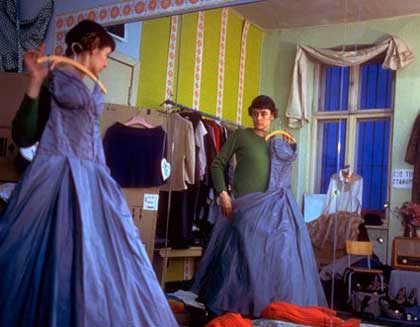
Volksboutique, 1996-1997
One of the more reproduced photographs from the Volksboutique store shows me holding up an actual debutante's ball gown in a wall-sized mirror. There was a fair bit of sniping regarding that image, that it was self-serving or narcissistic, etc. But what it was was my trying something out that interested me. Sizing it up, putting it on.
The aesthetic of the Volksboutique object is very peculiar. What inspired it?
 The name Volksboutique stems from the VEB, or VolksEigenen Betrieb, which was the socialist term for collective ownership and industry in the GDR. I moved to Berlin Mitte in 1991, and it was a profoundly different aesthetic experience than today, not to mention from that which I was accustomed having grown up in the States. The remnants of the GDR were everywhere, literally cast out on the street in piles day by day. I wandered the streets daily hauling in everything I could physically transport home. A store called "Dumping Kuhle" sold off stockpiled VEB products that were suddenly rendered valueless. That was the environment I lived in, and so it naturally entered my work.
The name Volksboutique stems from the VEB, or VolksEigenen Betrieb, which was the socialist term for collective ownership and industry in the GDR. I moved to Berlin Mitte in 1991, and it was a profoundly different aesthetic experience than today, not to mention from that which I was accustomed having grown up in the States. The remnants of the GDR were everywhere, literally cast out on the street in piles day by day. I wandered the streets daily hauling in everything I could physically transport home. A store called "Dumping Kuhle" sold off stockpiled VEB products that were suddenly rendered valueless. That was the environment I lived in, and so it naturally entered my work.
However, this is not exclusively a GDR nor Ostalgic thing. My residence in Brooklyn had me obsessed with visual elements I found locally, for example, my studio there is housed in a former pencil factory. Many elements invoke a hand-made aesthetic, and I have a predilection for cast-off objects. I collect 50s office furniture, vernacular signage, manual typewriters, and have a mini-museum of vintage stationery products.
Volksboutique is to a large extent about examining concepts of âvalueâ in our culture and re-investing discarded appurtenances with meaning and use. Iâm trying to point viewersâ attention to specific objects and events in life that risk being overlooked as being too quotidian or too common.
One of the mottos of Volksboutique is "Make the most of what you've got." Are there examples in your life when you had no choice but "make the most of what you had"?
I think I could answer this many ways. In my family, there is a particular tic to be constantly striving for a point of "readiness" or "departure" that is pretty unattainable, and can be frustrating. What I mean here is, that "work" can only get done once every little other thing is done â" dishes washed, clothes straightened, recycling out, checkbook balanced â" rendering a clean slate so that this WORK can begin. But this is a state that will never really be attained! I realized pretty early that rather than waiting for this ultimate constellation or alignment of graces, or whatever, that I simply had to jump in and work with whatever was at hand. This could easily be seen in financial terms, that when XXX stage of financial security is arrived at, THEN XXX can be achieved. Rather than waiting for an impossible or utopian situation to suddenly arise, better to get to work and create a better situation. I mean, I moved to Berlin with no permission to be here, not speaking the language, and with really no obvious skill set that differentiated me from anyone else...and so working within these limitations became my project.

Volksboutique Accounting Archive, 2002
With regard to being a practicing artist, especially since entering the teaching community, there is this misunderstanding to dispel that one entered an art career with other cards than anyone else. What I mean here is that I went through the same channels that anyone would: art school, move to urban environment, work, dialogue within the art system. People are not born with cards optioning them to art careers, (or any careers). There is no mystical thing that suddenly bestows an artist with a career. An artist works and finds him/herself in the midst of it.
I also understand art making to be less about the invention or construction of new things, but more about the close paying attention to and realignment of existing things.
What is Christine Hill doing when she's not keeping the shop? I'm particularly curious about the work of your students.
Well, I make a lot of lists. And I am a master procrastinator. It is sort of a job in itself. But yes, one of the larger re-structurings of my work life since 2004 is that I teach full time at the Bauhaus University. I chair the department "Media, Trend and Public Appearance" within the media faculty. This is something that sort of serendipitously presented itself to me, and turns out to have been fairly revolutionary for me. I am lucky that teaching is less a diversion from what I normally would be doing, rather it is a pretty natural extension of what I do. And though it has taken some getting used to in terms of the organization of my working time, I find myself impressed and inspired by my students to an amazing degree. The math for embarking on a career as an artist is not necessarily in one's favor, and the culture â" even if we happen to be in some art market boom right now â" doesn't necessarily jump over itself in appreciation for the artistic occupation. So these people are incredibly brave, and I appreciate them following their instincts, and their being uncompromising about what they demand from their lives. And it is there that I can offer the most guidance. I am not necessarily sitting sitting with them teaching them software or how to patina something to a particular finish. More so, it's training them for the long fight. To instill in them a rigor, so that they can go out with that in their toolkit. I'm not trying to scare them, but I am trying to explain to them what will be required of them in terms of discipline and focus. Furthermore, I am myself a huge fan of good work, and when my students come up with good projects, I'm just completely invigorated by that.
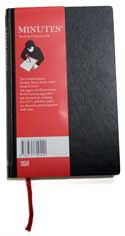 Can you tell us something about the work you're preparing for the upcoming Biennale of Art in Venice?
Can you tell us something about the work you're preparing for the upcoming Biennale of Art in Venice?
Well, that aforementioned Second Book is the main contribution for Venice. It is entitled Minutes (as is the entire piece for Venice) â" referring to detail, minutae; the passing and accruing of time; and of course, taking meeting minutes, the tallying of progress.
The book as an object is patterned after a calendar/datebook. In considering what one could/should put in an exhibition like Venice, there seemed to be pressure for Big Project, and I sort of dislike the notion of the masterpiece or opus. I like the continuum, that the machine is humming, that things are ebbing and flowing insofar as industry is concerned, and that many factors contribute to the so-called Process. This is most easily evidenced by a glimpse into my own datebook. So, the piece for Venice speaks to that...how my (or the mind) is organized, and what things are in there, and they can be very small things, and that it is something about growth via accumulation. And organization. I like that haircut appointments reside in the same space as big deadlines, and so-called Events of Note.
"Minutes" features work since the Inventory book, and texts I've written on them. There is a marvelous essay at the beginning by the author and musician (and my friend) Rick Moody. The publication was designed by the Leipzig-based Markus DreÃen (as was Inventory) and he is simply a masterful talent. Our collaboration is one that I am incredibly proud of.
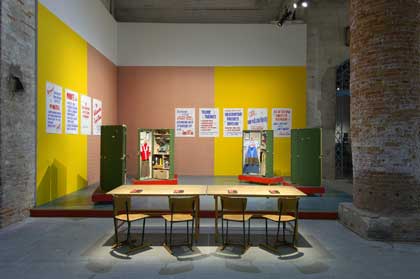
Minutes, installation view at the Venice Biennale, 2007
In addition to the publication, which is displayed in a sort of reading room environment, there is an installation of my Trunk Show in the Arsenale. These are a pretty spot-on manifestation of how my work and thought process organize themselves. The idea for this trunk system came from a conversation with my sister a number of years ago. She had visited a 60s submarine-turned-museum in Hawaii, and was extolling the wonders of how the interior worked...the attention to detail, how every little thing had its place in order to economize space, etc. She exclaimed "It was SO Volksboutique!". I realized that at that time, it wasn't particularly that any Volksboutique pieces were like this, but that my sister has such a good understanding of how my mind works, that she knew I would identify with this sort of organizational system. And so, the trunks were about making a physical representation of that. They isolate a five day work week into 5 governing tasks (Accounting, Management, PR, Production and Reception) and there are the complete accouterments for each of these occupations in each trunk. They are about economizing space and also rendering these tasks mobile.
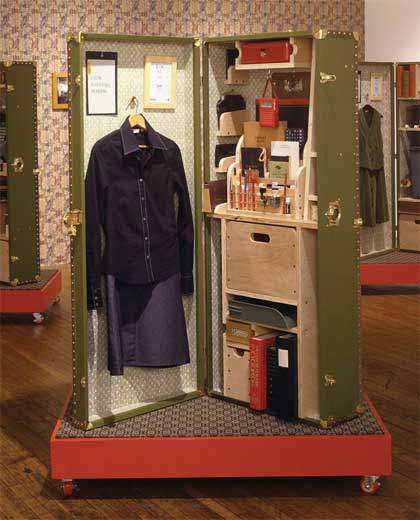
Accounting Portable Office
My Brooklyn studio is right alongside the workspace of Booklyn â" a bookmaking artist alliance that I've worked closely with since having been in New York. Particularly my friendship and collaboration with Mark Wagner â" who manufactured these trunks as over-dimensional, exploded "books" â" is important to me, and the show pays homage to that.
Name us 3 to 5 artists whom you think should get more attention from the public.
Well, I will preface this by saying that these are artists I admire and am inspired by, and am lucky enough to be friends with.
But I am not inferring that they are necessarily under-respected or underexposed in any way. But it is certainly excellent if even more people learn about them, because they all do amazing work. I notice that they are all mostly based in New York, which certainly means I need to get out in Berlin more!
Allison Smith (The Muster and Notion Nanny.)
Nina Katchadourian
J. Morgan Puett
Pablo Helguera
Michael Rakowitz.
Thanks Christine!
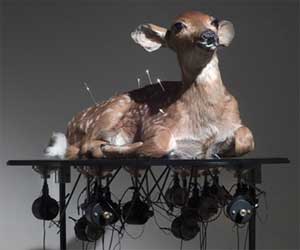 After a friend died from melanoma, Chicago-based artist Joseph Kohnke realized that even small imperfections on the surface of the body could consume oneâs entirety, and how markings on the skin can act both as camouflage â" increasing chances of survival â" as well as harbingersrbingers of death.
After a friend died from melanoma, Chicago-based artist Joseph Kohnke realized that even small imperfections on the surface of the body could consume oneâs entirety, and how markings on the skin can act both as camouflage â" increasing chances of survival â" as well as harbingersrbingers of death.
With Marked, Kohnke explores skin as the indicator of well-being.
The installation consists of a medical examination table with a conveyor belt containing photographs of the artist's skin. A scanner scans the photos puncturing the paper whenever a mark that could be seen as a flaw or as life threatening is spotted (freckle, scar, mole.) These punctures are then fed through a vacuum system similar to a player piano employing 14 tuning forks transforming them into spatial sound. In the next room, a taxidermied fawn receives the same signals, as lights pop out from beneath its fur.
Some of Kohnke's works are currently on show at the Art Lab gallery in Beijing's 798 art district.
Thanks Joseph Magliaro.
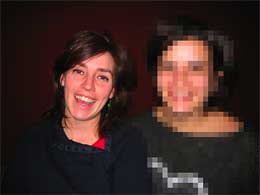 Bonjour les enfants, here's another project seen at the RCA's Great Exhibition in London.
Bonjour les enfants, here's another project seen at the RCA's Great Exhibition in London.
With IDPS (IDentity Protection System), interaction designer Miquel Mora is proposing a new way to protect our visual identity from the invasion of ubiquitous surveillance cameras. He had a heap of green stickers that could stick to your jacket. Or anywhere else. The sticker blurred your image on the video screen.
"With the IDPS project I wanted to sparkle debate about all the issues related to identity privacy," explains Miquel. "Make people think about how our society has become a complete surveillance machine. Our identities have already been stored as data in many servers ready to be tracked. And our self image is our last resort. So we really need tools to protect our privacy. We need tools that can allow us to hide or reveal our visual image. We must have the control over it."
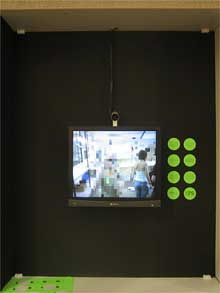 "For example in one scenario a girl is wearing a tooth jewellery with IDPS technology embedded. So when she smiles she reveals it and it triggers the camera to protect her. With IDPS users can always feel comfortable, knowing that with a simple gesture like smiling, they are in control. The IDPS technology could be embedded in all kind of items, from simple badges to clothes or jewellery. For the working prototype I'm using Processing to track the stickers and pixelate the image around when it founds one."
"For example in one scenario a girl is wearing a tooth jewellery with IDPS technology embedded. So when she smiles she reveals it and it triggers the camera to protect her. With IDPS users can always feel comfortable, knowing that with a simple gesture like smiling, they are in control. The IDPS technology could be embedded in all kind of items, from simple badges to clothes or jewellery. For the working prototype I'm using Processing to track the stickers and pixelate the image around when it founds one."
Couldn't help but ask Miquel how visitors of the exhibition reacted to his project, are they still bothered by surveillance cameras these days?
"I think people like it first because it's fun to play with but then everyone says that yes, we should have tools like that to protect our privacy. And although everyone is used to surveillance cameras all wish they could have something like this.
I need to say that there have been few people that the first thing they said is that technology would be perfect for terrorists! But I guess this is like any other technology, what is bad is the way we use it."
Thanks Miquel!
Blogged by Hack41
. . . . . . . . . . . . . . . . . . . . . . . . . . . . . . . .

0 Comments:
Post a Comment
<< Home